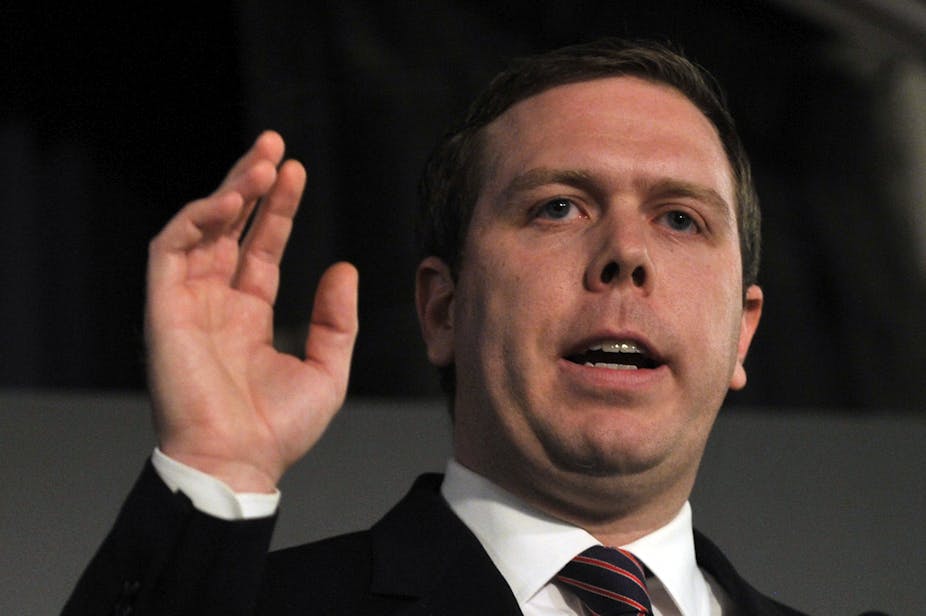Governments and their partisans are usually reluctant to admit that they might be unpopular for a reason. Labor partisans have offered many explanations for the unpopularity of the Gillard government: for a long period Tony Abbott was credited with truly magical powers, despite all the evidence that he is an unpopular opposition leader.
Perhaps Labor’s campaign against the Greens represents another development in Labor’s crisis. Political operatives and much of the media define politics as about symbolism and “leadership”. Both left and right wildly overestimate the ability of elites to drive public opinion. It has been suggested that John Howard could have stopped Pauline Hanson by a few words or that if Labor MPs after 1996 had said kinder words about Paul Keating, John Howard’s Liberals would never have come to be perceived by voters as great economic managers or the preferred party on economic management.
This magical thinking has reached a new height with the assertion that voter dislike of the carbon tax is because of the government’s supposed “alliance” with the Greens, as if Labor could have somehow assembled a parliamentary majority by force of will alone. I suggest that behind the rhetorical absurdities of Paul Howes and his colleagues lies a more coherent argument: Labor has become too left wing.
It is no coincidence that a leader of the Australian Workers’ Union should believe this. The AWU now incarnates the spirit of the contemporary Australian labour movement as it did once before World War II. Then the AWU was the backbone of the Labor right. It was a union that represented poorly skilled workers who worked in small workplaces and who (particularly before World War I) were often small farmers. Thus the AWU leadership were zealous champions of the industrial arbitration system.
During World War I, the AWU spearheaded the exclusion of the extreme pro-conscriptionist right from the ALP. After the war, the AWU leadership’s cautious pro-arbitration labourism was challenged both by many AWU members and by industrial unions. Eventually the challenge from the left was defeated. Many techniques were employed: the corruption of AWU and Labor Party elections, alliances with employers against militant workers and the repression and victimisation of militant workers by sympathetic state Labor governments.
Paradoxically the strength of class identity in Australia aided the cause of the Labor right represented by the AWU. Workers were intensely loyal to political labour; once the right had reasserted its control over the party, Labor was secure from electoral challenges to the left - even although many workers were disappointed with Labor’s record in government. This crusade of the AWU’s leadership was not a pretty one, but perhaps from a narrowly electoral perspective the AWU was correct. The radicalism of the industrial left frightened voters. Interwar Labor was strongest in those states where the AWU dominated the labour movement.
The AWU’s dominant position within the labour movement eroded after World War II. Economic change undercut the pastoral workforce. In the 1950s, the AWU played a leading role in the expulsion of the extreme right from the ALP when it mobilised against the industrial groups. However, in the post-split ALP, the AWU was progressively excluded by the ascendant left within the party, and the union was no longer strong enough to carry the ALP right on its own. The AWU’s model of pacific unionism, which was dependent on arbitration and sympathetic Labor governments, was less relevant to the affluent and conservative 1950s and 1960s. In these decades Labor governments were rare, and workers now often secured wage increases by collective bargaining rather than arbitration. The AWU’s archaic and racist rhetorical labourism also repealed the Whitlamite social democrats of Labor’s right.
The upheavals in the Australian economy from the 1980s set the ground for an AWU resurgence. The union benefited by advantageous mergers, but more significant was that the industrial relations landscape came to resemble that of interwar Australia. Unemployment was high and the arbitration system became much more important as a means of securing wage increases. Conservative governments championed employer prerogative to an even greater extent than those in interwar years. The balance of power between unions and the ALP reversed. Most unions were now dependent on state support just as the AWU had always been. Thus the priority of industrial labour became to keep the Labor Party in government. Industrial and political labour became increasingly integrated.
In the golden post-war years, the Communist Party had rivalled Labor as a pole of attraction for many union activists, but now political Labor activists enjoy an unprecedented dominance of industrial labour. The Greens, however, pose far greater electoral challenge to Labor than the Communists ever did. Anti-unionism now seemed hardwired into the federal Coalition to a much greater extent than in the 1970s or 1980s or even the 1920s and 1930s. In the logic, then, of Paul Howes and many others in the ALP, the Greens represent a threat to Labor’s electability and hence, “objectively”, to the union movement. They have argued that as Green voters will always preference the ALP their concerns can be entirely ignored.
Labor’s current rhetoric against the Greens is partially an expression of frustration, but it also reflects a deeper anxiety about the survival of the labour movement. Panic may come to supplant realistic analysis and coalition-building for industrial and political labour.

